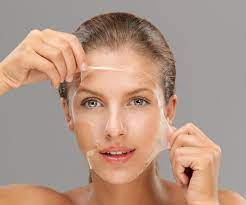If you’re curious about chemical peel, you’re not alone. These treatments are very popular, and are a great way to improve the look of your skin. Before you schedule an appointment, though, you’ll want to read up on the different kinds of peels available. You can also learn more about what chemicals are used to perform the procedures.
Table of Contents
Glycolic acid
Glycolic acid is a skin care ingredient that can be found in many cosmetic products. It is derived from sugar cane, and it has several antioxidant and anti-inflammatory properties. It is gentle enough to use on most skin types. It is also known for its anti-aging properties, and it helps with acne.
It is also commonly used in chemical peel. These peels remove dead cells, stimulate collagen production, and promote cell turnover. This process allows the skin to regenerate and rejuvenate.
A glycolic acid peel can improve the skin’s tone and texture, soften fine lines, and reduce acne. The peel also has anti-inflammatory and antioxidant properties.
Unlike other exfoliating agents, glycolic acid does not cause irritation. It has a small molecular size, which allows it to penetrate the deeper layers of the skin. It also has keratolytic properties, which soften the outer layer of the skin.
Lactic acid
Lactic acid is an alpha hydroxy acid (AHA). It is a natural molecule found in milk and muscle tissue after exercise. It is water soluble and is used in chemical peels to help reveal fresh skin cells.
There are many different types of lactic acid peels available, ranging in strength from 10% to 30%. Some of them are more-gentle than others, depending on your sensitivity and skin type.
It is also important to note that the number of sessions needed to achieve the desired results will vary. A good rule of thumb is to use the milder products first. This will allow your skin time to adjust to the treatment.
If you are unsure about lactic acid, it is a good idea to consult with a Celebrity Dermatologist in Mumbai. People with naturally darker skin may not want to try a stronger product, since it could aggravate existing hyperpigmentation.
Trichloroacetic acid
Trichloroacetic acid (TCA) is a peel treatment which can treat a variety of skin conditions. It can also be used to help reduce acne scars. It is also useful for reducing sun damage and treating age spots.
TCA is most often combined with AHAs. These acids are used for exfoliation, reduction of hyperpigmentation, and wrinkle reduction. They are also used for skin moisturization.
In a study by the American Society of Plastic Surgeons, chemical peels were found to be the most commonly used nonsurgical procedure. The average physician/surgeon fee for a chemical peel is $644.
The American Academy of Dermatology reports that trichloroacetic acid can be used to reduce edema, erythema, and inflammation. In addition to increasing the rate of new skin cell growth, it can also trigger the skin’s defense system.
Salicylic acid
Salicylic acid is a chemical peeling agent that works to unclog pores and improve the appearance of your skin. It is a good treatment option for oily or acne-prone skin. A salicylic acid peel helps to minimize the appearance of enlarged pores, smooth out the skin, and remove the bacteria associated with acne.
It can be found in many over-the-counter acne products. These include cleansers, moisturizers, and sunscreen. When used in a high concentration, salicylic acid can help reduce acne inflammation. It also helps to improve the appearance of fine lines and wrinkles.
Professional salicylic acid peels are performed by the best dermatologist or esthetician. These are stronger peels that are more effective than at-home versions. They have higher concentrations of the peeling agent and can be done in a salon setting.
Retinoic acid
Retinol peeling is a minimally invasive procedure that improves the overall skin texture and tone. It also provides relief from fine lines and acne breakouts. In addition, it can help reduce scars and improve pores.
The procedure is performed at 6-8-week intervals. It is ideal for those who have fine lines, sun damage and hyperpigmentation.
Patients should avoid sun exposure and tanning for a minimum of 72 hours before treatment. It is recommended to wear a broad-spectrum sunscreen daily. Retinoids can help reduce post-inflammatory hyperpigmentation in dark skinned individuals.
There is a risk of mild discomfort and sensitivity. However, most of the side effects are transient. Ice packs or over-the-counter pain-relieving medications can help with discomfort.
A 5% retinoic acid peel was applied to the skin. Then, a lubricating cream was applied. Both were manufactured by the same pharmacist.

